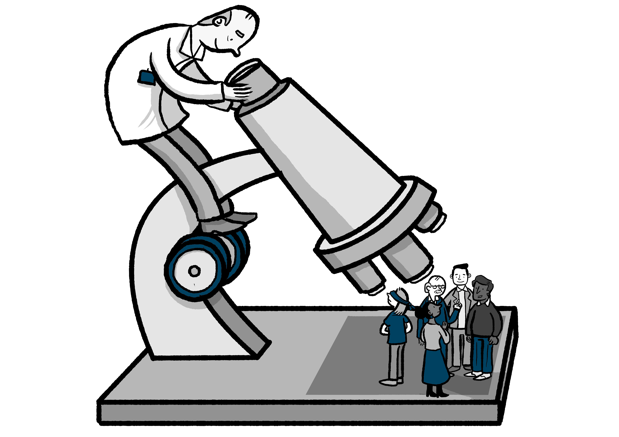Putting Your Team “Under the Microscope”
Most business owners have problems as they try to grow their business and move beyond the "In-Between-Zone".
Maybe it's time that you put your team "under the microscope"?

A couple of the common symptoms of "In-Between-Zone" businesses is that they have good management but because of their entrepreneurial business background they have usually not been trained to manage - combined with having a great team but they don't always pull together in the same direction.
Unfortunately, the business owner is often "blind" to these issues. More accurately, the owner has got so used to working with and around these people that they just accept their behaviors as the norm - "that's just the way person X always behaves".
By taking a new strategic approach a business advisor/facilitator can provide the business owner with the opportunity to both:
- Clarify their business vision and change plan.
- Simultaneously put their team "under the microscope" and identify the typical "desire" issues in their business.
The business advisor achieves this by separating out the "left hand side strategy" from the "right hand side strategy".
Working with the business owner on their Vision (their "right hand side"/ creative strategy) allows the owner to clarify what they want their business to look like in the future. It also allows them to identify the key ("strategic thrusts") change areas required to move the business forward in the shorter term.

The next step is for the business owner to focus on those detailed change areas ("left hand side" / practical strategy) with their management team, and build a detailed implementation plan.

Once you have done that, individual areas of team accountability will become much more obvious (at least in so far as they relate to this particular strategic project).
At this point, rather than leading the change process (as they instinctively would), the business owner is better advised to just step back and watch their team in action on this particular project. Imagine you as the owner are just a "fly on the wall" or watching your team in action “from behind a secret curtain". What do they see?

The key question is - are your team all equally bought in? It's normal to see some of the team much more "engaged" or "enthusiastic" than others. It's also normal to be able to clearly see those at the other end of the spectrum - the "actively disengaged" (or "cynics" as we sometimes call them).
In any business change exercise we would expect to see a relatively small percentage of "zealot-like enthusiasts" and "cynics", with the majority of your team (60% to 70% of the team) falling somewhere in between those two extremes. The key aspect that the owner needs to understand is the "dance" that happens between these groups will determine your pace of change.
If the owner lets the "cynics win" / determine the pace of change, that will demonstrate (the rest of the team in the middle) that nothing is going to change - and they will quickly revert to "business as usual" and the change process will typically stall.
However, the business owner with a strong desire to maximize their business potential will recognize that they need to identify the "cynics" (having put them "under the microscope") - and then work with those "cynics" more closely to actively drive the change process.
Sometimes those "cynics" just need more help, guidance or training - and they will grow their skills and levels of motivation (ideal outcome). Sometimes, the owner will come to the conclusion that more drastic action is required (a “kick in the pants” or worse perhaps).
Importantly (and either way) the rest of the team will recognize that the owner is serious about implementing necessary business changes. The team will truly understand that this is not going to be yet another of those change initiatives that we start but don't properly finish (classic "In-Between-Zone" behavior).
By using the “Trojan horse” of "we are working on business strategy" it will be much easier for the business owner to put their team "under the microscope".
By working together with an external facilitator – the business owner will be able to clearly "see the wood for the trees" and hold their people accountable.
